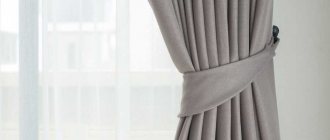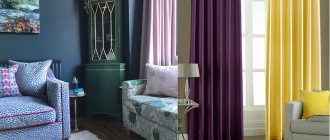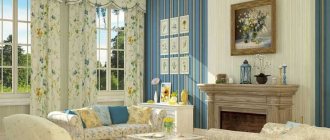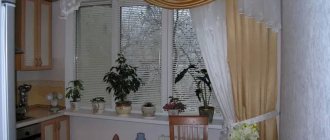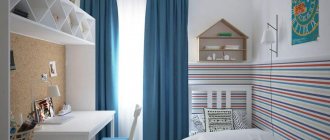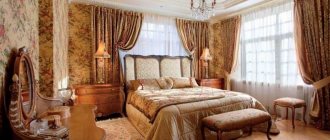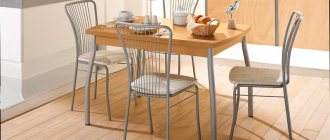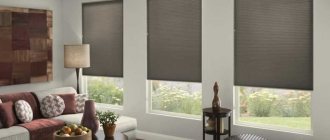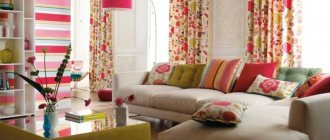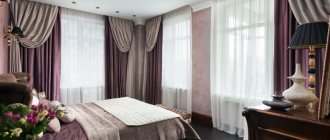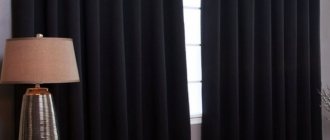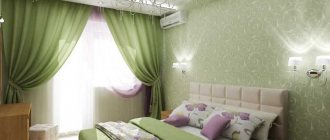Functions of curtain tiebacks
In addition to decorative purposes, curtain holders perform several important functions:
- Eliminates the need to constantly draw curtains;
- Help to secure the space of the room. For example, to prevent the curtain from falling onto the kitchen stove or into the sink;
- Help regulate the level of room illumination;
- Protects the appearance of curtains. Since the curtains do not need to be drawn and drawn down regularly, the curtains stay cleaner longer;
- Depending on the height at which the grab is fixed, the geometry of the window visually changes.
Types of grabs
There are these types of pickups:
- hard;
- fabric;
- wicker;
- designer (made to order or independently).
Kanzashi
They are a hairpin of any shape, trimmed with silk or satin ribbons and flowers. They are made using the Japanese technique Hana kanzashi. Square pieces of tape 2.5-3 cm wide are folded diagonally, and then in half using tongs they are shaped into petals, which are glued to the base.
Hard
Static holders are made of metal, plastic or wood. In shape they resemble a hook, a knob handle (the curtain is thrown over such a tie without creasing) or a hairpin, which consists of a base and a pin.
The base can have the shape of one or several rings, an oval, a square, a heart, a triangle, etc. It is decorated with ornaments and patterns.
Magnetic
The models consist of 3 parts: a decorative element, a base (magnets) and a jumper. The curtain is captured by a jumper and the magnetized elements are connected to each other through a layer of fabric. The decorative detail, decorated with rhinestones or enamel, remains in the foreground.
Cords with tassels
This type of tie is considered classic; it matches noble and heavy curtains. Depending on the production technique, twisted, braided and knitted cords are distinguished. Brushes are located at both ends. They must match the color of the cord. Sometimes the product is tinted with gold or silver paint.
Fabric
The holders are sewn from the same fabric as the curtains, or in a contrasting color. The standard “banana” model has a shape that is tapered at the ends. It is sewn on both sides, with or without internal lining. In the hardest models that hold their shape well, there are plastic inserts between the layers of fabric.
Decoration includes embroidery, fringe, ribbons, beads, ruffles, beads, etc.
Homemade
Homemade tiebacks include any devices and products that can fix and hold an assembled curtain, for example:
- round door handles in vintage style with beautiful forging;
- leather belts;
- suspender;
- threads woven in the form of braids or using the macrame technique;
- ties;
- carbines;
- wooden spools of thread strung on a rope;
- patches, scarves.
Fabric
In the classic version, fabric tiebacks are a wide ribbon sewn from the same fabric as the curtains. If you decide to sew curtains yourself, you can easily make curtain tiebacks with your own hands. To do this, just cut out a rectangle of fabric of the size you need, tuck it in and stitch it on a sewing machine.
Modern interior designers advise not to settle on the same material for curtains and tiebacks. Colorful curtains will be beautifully complemented by plain tie-backs. Bright fabric tiebacks can be used as an accent along with calm curtains or tulle. The grabber is attached to a holder mounted on the wall.
Extraordinary options for fixing curtains
In addition to the option described above, there are many other methods.
- How to choose a good shower for your bathroom
- Hallway hanger - choosing a unique and practical accessory
- How and when to refill a propane tank?
Designers suggest making your own curtain clips. They allow you to fix the curtain in the required position.
It can also be various hooks that have an original design.
It is believed that the classic option is when the tiebacks are 15 centimeters from the edge of the curtains. This arrangement creates the effect of a large space.
Hard
If fabric and cord models also require holders for grabs, then rigid structures replace two parts at once. The rigid hook structure is mounted on the wall. The curtain does not need to be tied, it is simply pulled up by the fastener.
Rigid holders are made of wood, plastic and metal. The latter are preferable because last longer and come in a variety of shapes and colors. In curtain haberdashery stores you can find both very laconic and elegant models.
Varieties
The photo shows that decorative accessories come in a variety of shapes and sizes. If desired, a DIY curtain clip can be made quite quickly. The main thing is that the finished product is harmoniously combined with the overall design of the room and matches the curtain itself. There are many options for using decorative elements. They can be combined in color with the main fabric, or in shape with a lambrequin. And you can make it contrasting in color and configuration in relation to the curtain composition.
Clips for thread curtains in the shape of butterflies or flowers will perfectly complement a romantic setting. Bronze or gold-plated options will be an excellent addition to elegant curtains in a classic style. For lovers of ethnic variations, it is recommended to make them yourself or purchase ready-made wooden accessories. Curtain clips for threads can be supplemented with rhinestones, chains, beads, fringe, and beads. This decor will add playfulness and originality to the interior design.
DIY fabric tiebacks
To make fabric tiebacks, you will need fabric, double tape, bias tape, thread, scissors, a pattern, and a sewing machine.
- Rectangular tiebacks at the point where the hinges are attached can form unsightly gathers. To avoid this, the pattern must be constructed in the form of a wing, straight at the top and semicircular at the bottom. Where the edges meet – the corner is truncated. Build a figure on paper.
- Fold the fabric in half with the right side inward, attach the pattern and trace with chalk. Make an allowance of 1-1.5 cm on each side.
- Cut out another piece of scaffolding from dublerin.
- Place the doublerin on the wrong side of the fabric and iron it to make the fabric stiffer.
- Make loops from bias tape. To do this, fold the pieces of tape in half and sew them.
- Fold the parts face inward, place loops on the sides, baste;
- Sew the pieces in a circle, leaving the bottom edge unstitched;
- Turn the tie back out and iron;
- Sew up the bottom edge;
If desired, the edges of the tieback can be treated with bias tape, and the junction of the loops and the tieback can be disguised with decorative elements.
Photos of curtain tiebacks
0
